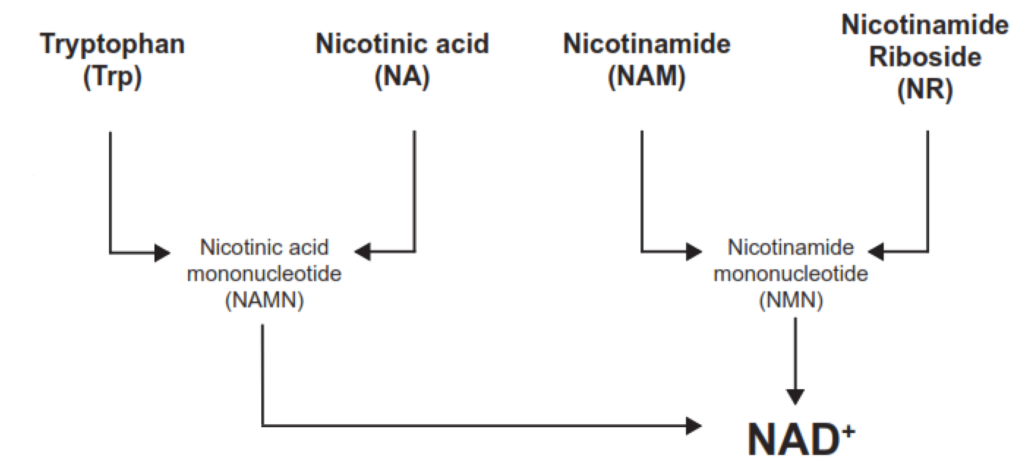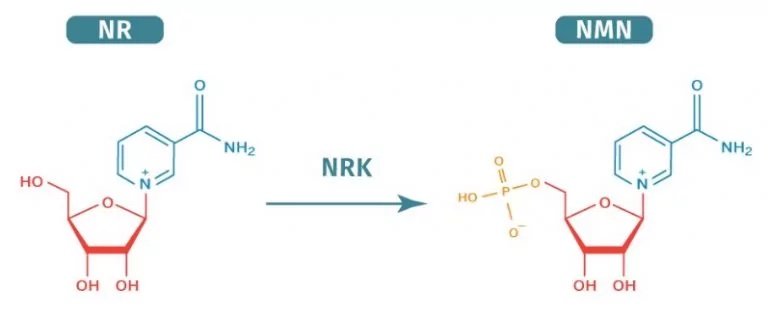What’s the Difference Between NMN, Niacin, and Vitamin B3?
In the body, vitamin B3 is converted to NMN (nicotinamide mononucleotide), which is converted to NAD+ (nicotinamide adenine dinucleotide).
Highlights:
- Nicotinic acid/niacin, nicotinamide/niacinamide, and nicotinamide riboside are different forms of vitamin B3, while NMN is not.
- Each form of vitamin B3 offers unique benefits, including lowering cholesterol and counteracting skin aging.
- Studies have shown that nicotinamide riboside and NMN have similar effects.
In a world of facts and plentiful information, confusion surrounds the similarities and differences between NMN (nicotinamide mononucleotide) and vitamin B3. To put it simply, NMN is not vitamin B3. The three natural forms of vitamin B3 are nicotinic acid (NA), nicotinamide (NAM), and nicotinamide riboside (NR). However, all three forms of vitamin B3, as well as NMN, are converted to NAD+ — a source of biological significance.

(Image: Canto, 2022) Vitamin B3 (NA, NAM, and NR) and NMN are converted to NAD+.
The vital importance of maintaining adequate NAD+ levels was partially realized in 1937 when pellagra — a deadly disease — was found to be caused by vitamin B3 deficiency. As such, the synthetic version of NA, named niacin was created, along with the synthetic form of nicotinamide, called niacinamide. Today, niacin is a blanket term used for vitamin B3, NA, NAM/niacinamide, and sometimes NR. However, in addition to boosting NAD+, each of these compounds appears to contribute to different biological processes in the body, offering unique benefits.
Unique Benefits of Vitamin B3s and NMN
Nicotinic Acid/Niacin
NA is perhaps the most well-known form of vitamin B3. It has been used for decades to treat and prevent pellagra, characterized by dermatitis, diarrhea, and dementia. NA is widely recognized for its ability to improve cholesterol levels. It increases high-density lipoprotein (HDL) cholesterol and decreases low-density lipoprotein (LDL) cholesterol and triglycerides. By improving cholesterol levels, niacin can help reduce the risk of cardiovascular diseases.
Nicotinamide/Niacinamide
NAM, also known as niacinamide, is another form of vitamin B3. Unlike niacin, NAM does not have the same lipid-altering effects and does not cause the “niacin flush,” a common side effect of NA characterized by redness and warmth of the skin. NAM is a popular ingredient in skincare products due to its anti-inflammatory properties and ability to improve skin barrier function, reduce hyperpigmentation, and minimize fine lines and wrinkles. It has also been studied for its potential to improve joint flexibility and reduce symptoms of osteoarthritis.
NR and NMN
NR and NMN were discovered more recently than NA and NAM. Boosting NAD+ levels with NR and NMN has been associated with improved mitochondrial function, increased energy production, and enhanced cellular repair mechanisms — key contributors to healthy cellular aging. Furthermore, research suggests that increasing NAD+ levels through NR or NMN supplementation may help combat age-related diseases, improve muscle function, enhance cognitive performance, and extend lifespan.
While both NMN and NR are effective in raising NAD+ levels, they differ in their biochemical pathways and potential benefits. NMN is directly converted to NAD+ in cells and shows promise in clinical studies for improving physical endurance and metabolic health. NR is converted to NMN before becoming NAD+ and has been studied for its effects on neuroprotection, cardiovascular health, and metabolic regulation.
Choosing the Right Supplement
In summary, vitamin B3 is a broad term used to describe a water-soluble vitamin that is part of the B-vitamin family and includes NA, NAM, and NR. While the NMN molecule consists of an NR molecule, it is not considered a form of vitamin B3. Still, each of these compounds offers unique benefits:
- NA is best known for its role in cholesterol management and cardiovascular health.
- NAM is prized for its skin health benefits and cellular repair functions.
- NR and NMN are gaining recognition for their potential to boost NAD+ levels, offering anti-aging and metabolic health benefits.

Nicotinamide mononucleotide (NMN) is similar to nicotinamide riboside (NR) but has a phosphate group (yellow). NRK (nicotinamide riboside kinase) is the enzyme that converts NR to NMN in cells.
Understanding these differences can help with choosing the right form of vitamin B3 or NMN based on specific health goals. Notably, compared to NR and NMN, the benefits NA and NAM are based on a longer history of evidence and clinical outcomes. While emerging research suggests that NR and NMN could have similar effects to NA and NAM, further studies will be needed to determine if NA and NAM have similar effects to NR and NAM. It seems likely that all four compounds have overlapping effects that may depend on how well they elevate NAD+ levels.

